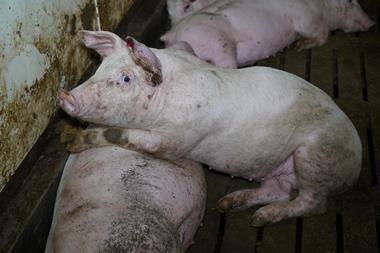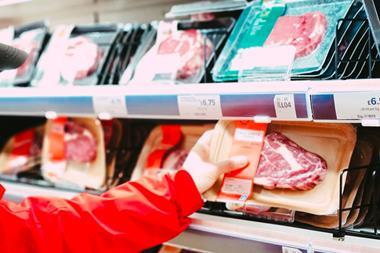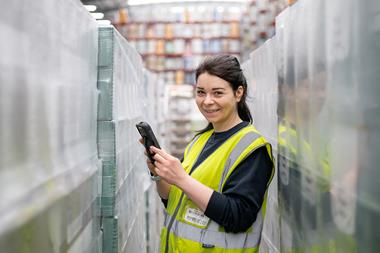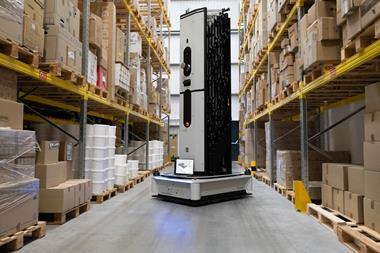Faced with rising costs, labour shortages, rising demand for rapid delivery in urban centres and the increasing need to decarbonise, UK grocery retailers are rethinking how their supply chains are structured and where they’re based. As demand grows for more efficient and sustainable fulfilment, many of the biggest names in food retail are consolidating into new, future-ready logistics facilities designed to meet the challenges of a rapidly changing market.
The transformation of food and drink retail has been years in the making, but recent shifts in consumer behaviour, technology and logistics have pushed it into a new era. With the trend towards online sales accelerated dramatically, grocery retailers face challenges on various fronts to deliver cost-effectively and efficiently in an increasingly demanding consumer and policy environment.
According to Statista, whether it’s to avoid crowds, find deals or simply save time, grocery shopping online “has evolved into a popular alternative to physical supermarket trips in the UK”, with the number of people in the UK shopping online for food and other groceries nearly doubling since 2016. By 2025, internet sales accounted for 9.4% of all food retail sales, up from 5.4% in 2018.
In short, e-commerce is reshaping the grocery landscape and, alongside it, the logistics solutions required to meet this evolving market. Across Europe, research has revealed that e-commerce is also reshaping logistics, with the UK emerging as the most mature and complex market. Thirty-two percent of retail purchases are now made online in the UK, more than triple the rate in many continental European countries, so the balance is shifting from growth in volume, to growth in intensity.
Meanwhile, looking at the wider picture and its impact on grocery retail, a recent report from the National Preparedness Commission (NPC) has warned that the UK food supply chain faces risk from climate change and global instability, requiring UK retailers to safeguard their supply chains. One recognised weakness in the UK’s food system is its reliance on “just-in-time” supply chains, which prioritise efficiency but leaves little room for disruption. The NPC is calling for a decisive shift towards proactive, community-centred resilience planning.
While faced with the challenge of meeting these increasingly complex fulfilment considerations, grocery retailers are also having to battle rising operational and energy costs, a growing labour skills gap – from warehouse operations to HGV driver shortages – and increasing consumer expectation of same- or next-day delivery, alongside the challenge of fulfilling these orders efficiently in densely populated urban areas.
As a result, margins and profitability are under pressure, so they are seeking solutions that will offer super-efficient logistics management, and the ability to future-proof their operations.
Efficient and sustainable delivery
One solution coming increasingly to the fore – and already adopted by a number of the UK’s grocery retailers – is the use of intermodal logistics. This integration of road and rail transport enables retailers to move large amounts of goods from central distribution hubs and entry points to near their final location in both a time-efficient and sustainable manner. What’s more, research from Network Rail shows that each tonne of freight transported by retail produces 76% fewer carbon emissions compared to the road and, as a freight train can carry as much as 110 lorries, there is clear opportunity to reduce carbon footprint and help to cut down both traffic and gridlock on the nation’s roads.
At the heart of this evolution – and attracting the attention of some of the UK’s leading grocery retailers – is Prologis, an international specialist in logistics property development. Its major UK investment is Daventry International Rail Freight Terminal (DIRFT), an intermodal rail-road complex sitting at the heart of the country. This prime location, and the variety of facilities offered at the site, have encouraged keen interest and investment from (among others) Tesco, Sainsbury’s and, most recently, Marks & Spencer.
So, what is making Prologis’ RFI DIRFT site so popular with retailers?
The business’ central location at Daventry offers direct access to the West Coast main rail network, the UK’s primary freight route, with three rail freight terminals at the site and a high on-time performance lending supply chain resilience to retailer networks. Proximity to the UK’s highway network (M1and the M6/A14 interchange) means that HGV lorries operating from the site can reach 47 million customers in under 4.5 hours. This offers retailers supply chain resilience with more time-efficient delivery and contributing towards its customers’ enhanced sustainability goals.

Tesco has two facilities at the site – a cold store and rail served terminal – and operates 10 rail services from DIRFT every day. Since 2023, the retailer has been using Maritime Transport to plan and execute all rail operations at its central distribution hubs within DIRFT, citing its commitment to “efficient low-carbon logistics”. At the time, Nick Potter, transport director for Tesco plc, noted: “Rail freight is one of the many ways we’re reducing our emissions, and the network will play an important role in achieving net zero across our operations by 2035.”
Sainsbury’s, which operates its national distribution centre at DIRFT, also confirms that its central location ensures continuity of supply for the retailer’s customers and allows it to be “highly responsive to changing demand”, as well as helping it to reduce carbon emissions throughout its operation and supply chain.
Meanwhile, Marks & Spencer recently revealed its decision to relocate to DIRFT, investing in a new £340m automated food distribution centre, as part of plans to double the size of its food business. As reported by The Grocer, the centre, due to open in 2029, will span 1.3m sq ft and represents M&S’ biggest supply chain investment in its history.
As the development partner for the centre, Prologis described the development as a long-term infrastructure platform tailored to M&S’ future supply chain. And, at the time of the announcement, Prologis UK regional head Paul Weston said: “Together we’re combining automation sustainability and smart energy systems to deliver a site that supports growth, resilience and net zero ambitions.”
Helping grocery retailers to address the challenges
While the location of the DIRFT site and its intermodal capacity are key, a focus on other challenges faced by grocery retailers is adding to its appeal. Not least among these are facility’s flexibility, with building sizes ranging from 100,000 – 1.6m sq ft, and the ability to accommodate a high level of automation. In the case of Marks & Spencer, for example, the new development is set to combine chilled storage, advanced automation fulfilment supplied by TGW Logistics, as well as returns and recycling operations.
Energy and sustainability concerns are addressed, with buildings designed to achieve net-zero regulated energy use and to target BREEAM Outstanding – the highest level of sustainable construction design. Prologis has committed to achieving net-zero greenhouse gas emissions across its value chain by 2040 and to ensuring all of its current warehouse and office spaces are equipped with energy-saving LED lighting by the end of this year.

More than 10,000 people currently work across the DIRFT site in a growing range of logistics, operations and technical roles – and, in turn, Prologis is committed to making the location enticing for its clients’ current and prospective employees. The Hub at DIRFT is a training facility which provides on-site training and proactive assistance for employers located at the site, helping them to upskill and build a future logistics workforce.

To enhance employees’ physical and mental health and wellbeing, Prologis has introduced a multi-purpose sports facility, along with a nature reserve and community parks and trails within the DIRFT complex.
As e-commerce in the UK continues to develop, speed, convenience and resilience will characterise the success of UK grocery operations going forwards. A recent survey by PwC predicted that grocery industry experts expect the market share of online grocery shopping to increase to between 35% and 50% in a number of European countries, including the UK, by 2050. As a result, it says, eGrocers will need to “adapt and upgrade all operations, developing a lean discount assortment and tailored packaging for online order delivery, cost-efficient and automated last-mile delivery, automated infrastructure and efficient picking, and low-cost payment solutions”. And it adds: “While bricks-and-mortar stores will still have a significant market share, their revenue and profitability will be eroded as consumers take advantage of the convenience of new digital services. The full extent of the change to an omni-channel model and the exact road ahead are still unclear, but the grocery retailers already getting it right online are pointing the way.”
It appears likely that the Prologis RFI DIRFT site will prove a key building block in that strategy for UK grocery retailers in the years ahead. As Prologis’ Weston notes: “E-commerce will continue to be a key driver of demand – but the nature of that demand is changing. In a mature market like the UK, customers expect faster delivery, better tracking, and with sustainability built in. It’s shaping how we plan, build, and deliver logistics space.”
To find out more about future-proofing retail logistics with the help of Prologis RFI DIRFT, click here.






















